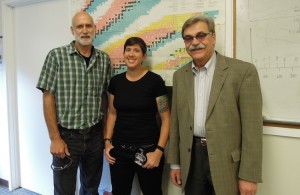May 21 2014
It’s now more or less official: element 117 will have a seat at the periodic table. Earlier this month an international team of scientists that included researchers from Lawrence Berkeley National Lab’s Nuclear Science Division found two atoms of superheavy element 117.
The experiment, conducted at a particle accelerator at the GSI Helmholtz Center for Heavy Ion Research in Darmstadt, Germany, builds on the previous 117 experiment by a different team working in Dubna, Russia in 2010 that identified six atoms of the superheavy element.
 (Left to right) Ken Gregorich, Jackie Gates, Heino Nitsche
(Left to right) Ken Gregorich, Jackie Gates, Heino Nitsche
Heino Nitsche leads Berkeley Lab’s superheavy-element research. The group is involved in not only in the verification of new elements like 117, but also in figuring out the best ways to do chemistry experiments with the few, fleeting atoms on the roster of superheavies. He and staff scientists Kenneth Gregorich and Jackie Gates recently discussed their roles in the new 117 experiment. They also described how their team, which includes scientist Greg Pang, does chemistry one atom at a time.
First of all, why do superheavy elements matter?
Heino Nitsche: The question is why elements matter, period. It’s because they are part of our daily life, and we are moving forward with our understanding of science. When I was young, we had element 106 and we thought that was it, that we’d never get any higher. In the last 30 years, we as a community have created elements 107 to 118 and confirmed most of these. So we have done the unbelievable, the unthinkable.
How were you involved in the most recent experiment to produce element 117?
Jackie Gates: Whenever you have any new results, you always want to make sure somebody else can verify it. That’s what we did. They did a data analysis at GSI and we also got a copy of the raw data. We wrote our own analysis code so we could look and see if we agreed with what they saw. We just brought a different point of view in the way that we approached the data.
Why are chemistry experiments of superheavy elements important?
Nitsche: We are trying to establish them in the periodic table and see if they are homologs to the other elements in their group. The principle of homologs is that as you go down the periodic table, all the elements in a column share properties because they share the same electronic structure—the outer electrons that bind to other atoms are in the same configuration. So far we’ve been lucky—they’re all homologs.
Why wouldn’t they be homologs?
Ken Gregorich: Because of relativistic effects. In superheavy atoms, the nucleus is so large that electrons around it move at close to the speed of light. This could mean that superheavy elements behave differently than other elements in their column. For instance, at one point, it was believed that element 114 might act like a noble gas, like helium or neon, but last year we found it behaves more like a volatile metal.
The 117 experiment, which lasted months, detected only two atoms of the element, and they decayed in less than a second. That’s too fast to do chemistry, but elements like 114 stick around for a little longer. How do you do chemistry one atom at a time?
Gregorich: Actually, most of the time, we’re doing chemistry with zero atoms. You can run an experiment to do 1000 chemical separations and maybe 10 or 20 times you get one atom through it. Element 114 has a half-life of a couple seconds to 30 seconds depending on the isotope. That’s enough time to do these separations in liquid and in gas, and the way the atom interacts with the liquid or gas tells us its chemical properties.
What’s next for single-atom chemistry?
Nitsche: We want to know if element 114 is more like lead or more like mercury. In the fall of 2014 we’re going back to GSI to do an experiment with even more specialized equipment to answer this question. At Berkley Lab, we are developing a microfluidic separation and detection system to establish aqueous chemistry experiments for elements 112 and 114, copernicium and flerovium, respectively. We are transferring an atom in very small amounts of liquid into an organic extractant on a microfluidic chip, and then measure it on another microchip detector. Because microfluidics happen in a small space, you can speed up the separation, and do it in less than a second. That’s a time scale we’re aiming for.
“Did You Know? Berkeley Lab researchers have discovered 16 elements on the periodic table.”